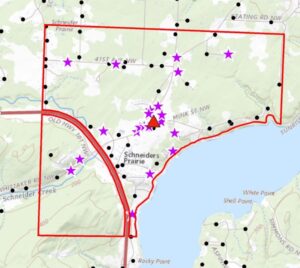Local residents are likely aware that over the last year or more, the Washington Department of Agriculture has identified a portion of Steamboat Peninsula, along with other locations in Western Washington, as a home for a growing population of the invasive spongy moth (formerly known as the “gypsy moth”). You may have seen the traps attached to trees around the Peninsula as the Department of Agriculture worked to find where the moth populations were located. That work is now done and the Department is now taking steps to reduce the spongy moth population. One of the steps being taken is the aerial spraying of Bacillus thuringiensis kurstaki or “Btk”. We’ve now received notification from the Department of Agriculture that aerial spraying will be happening soon.
UPDATE: The three aerial sprayings have now been completed. They were conducted on the mornings of May 16, May 19, and May 20. No other sprayings are scheduled this year. The Washington Department of Agriculture will evaluate the effectiveness and may schedule additional sprayings at a later date, possibly next year.
 The area identified for aerial spraying is relatively small; the entire Steamboat Peninsula is not being sprayed. The area centers on Steamboat Island Road and Sunrise Beach Road. The western boundary is a line running along Oyster Bay Road. The northern border is roughly the 4400 blocks of Oyster Bay Road and Steamboat Island Road. On the east is the Sunrise Heights Road, off Keating Road. The southern border is roughly the 2600 block of Madrona Beach Road. Click the image for a larger version.
The area identified for aerial spraying is relatively small; the entire Steamboat Peninsula is not being sprayed. The area centers on Steamboat Island Road and Sunrise Beach Road. The western boundary is a line running along Oyster Bay Road. The northern border is roughly the 4400 blocks of Oyster Bay Road and Steamboat Island Road. On the east is the Sunrise Heights Road, off Keating Road. The southern border is roughly the 2600 block of Madrona Beach Road. Click the image for a larger version.
If you live within this area you should consider signing up for alerts by email, a text message, or a phone call notifying you of when spraying will take place. Exact treatment dates are highly dependent on the weather. Click here to see the web page where you can set up the notification you prefer. Or call 800-443-6684.
“While Btk is not toxic to people or pets, it is sticky,” reads a recent postcard sent out by the Department of Agriculture. “When applied, it will leave a thin film on outdoor objects. You may want to cover outdoor vehicles or bring toys inside. If your belongings get Btk on them, it washes off with soap and water. Keep windows and doors closed during treatments and for 30 minutes afterward.”
A small airplane will apply the Btk treatments. These treatments usually start in the morning hours and continue until they are complete across the entire coverage area. There will be three treatments with three to 10 days between each one.
For more information about this aerial spraying and about the spongy moth, visit agr.wa.gov/moths. Email pest@agr.wa.gov. Call the Spongy Moth Hotline at 800-443-6684. And join the Spongy Moth Eradication Facebook Group.
